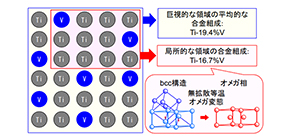
Phase transformation by quenched-in compositional fluctuations in titanium alloys clarified
Will assist the development of biological and structural materials using diffusionless isothermal ω transformation
A group of researchers from Osaka University and Tohoku University have demonstrated that there is a new phase transformation in titanium-vanadium alloy system, clarifying its mechanism, a world first. In this new phase transformation called “diffusionless ω (hexagonal)-phase transformation,” atomic diffusion does not occur but the ω phase transformation occurs at room temperature.
In titanium alloys essential for biomedical materials and structural aircraft components, an ω-phase transformation, in which the body-centered cubic (bcc) β phase transforms to hexagonal ω phase, occurs. The regulation of ω transformation has been studied because it is important in controlling chemical composition and mechanical properties of titanium alloys.
In terms of the transformation kinetics, the ω transformation has been categorized into two transformation modes: athermal and isothermal ω transformations. Athermal ω transformation occurs spontaneously via a diffusionless mechanism and a diffusion-mediated isothermal ω transformation takes place at temperatures above ~500 K.
This team demonstrated that there was a diffusionless isothermal ω transformation, which occurs spontaneously at room temperature via a diffusionless mechanism, clarifying the phase transformation mechanism. In addition, they revealed that diffusionless isothermal ω transformation was an anomalous phase transformation that took place in locally unstable regions formed by quenched-in compositional fluctuations, which are inevitably present in thermal equilibrium. For this reason, diffusionless isothermal ω transformation cannot be explained by conventional phase transformation theories that deal with macroscopic phenomena determined by average alloy composition.
Moving forward, the establishment of nanostructure regulation methods based on this team’s results will lead to the development of titanium alloys for biomedical medicine and structural materials which possess high intensity and low elasticity.
Figure 1. Phase transition from BCC phase to ω phase
Table 1. Classification of ω transformation
Figure 2. Macroscopically averaged and local chemical compositions in a Ti-19.7V (at.%) alloy and schematic illustration showing diffusionless isothermal ω transformation
The article, “Diffusionless isothermal omega transformation in titanium alloys driven by quenched-incompositional fluctuations” was published in Physical Review Materials at DOI: https://doi.org/ 10.1103/PhysRevMaterials.3.043604 .
Related links

